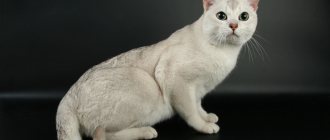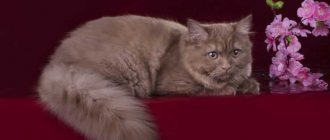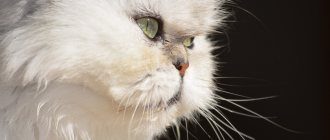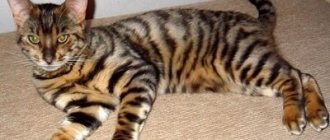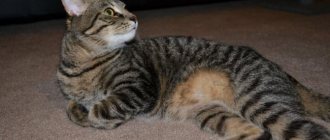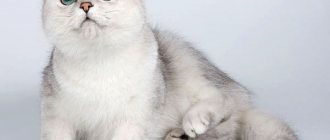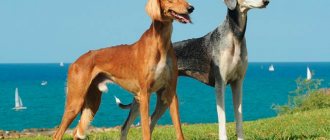History of the breed
The Tonkinese cat or “Tonkinese” got its name from the northern region of Vietnam, which was called Tonkin in the 15th-20th centuries.
Felinologists and breeders of our time suggest that the breed has been known to the world since the times when modern Thailand was called the Kingdom of Siam, and the ancient Siamese literary source “The Book of Poems about a Cat” described a breed that fully fits the description of Tonkinese.
In the photo there are Tonkinese cats: their resemblance to Siamese cats is no coincidence
A more accurate and officially established history of the breed dates back to the beginning of the 20th century: in the 1930s, the Tonkinese and Burmese breeds began to spread throughout the world.
IMPORTANT: the Tonkinese and the Burmese cat have a common relative - the Wong Mau cat.
In the photo, a cat of the Wong Mau breed is the progenitor of all Tonkinese and Burmese cats.
It is worth noting that the breeding of Tonkinese cats began with the crossing of Burmese and Siamese cats: the kittens received a very graceful physique and an unusual turquoise eye color. This discovery surprised felinologists and gave rise to the beginning of breeding a new breed.
The kittens have an unusual appearance and rich eye color
Here, enthusiasts had to face difficulties: for the manifestation of the signature Tonkinese color, it is necessary that one gene be Siamese, and the second – Burmese. According to the rules of genetics, only half of the kittens in the litter have characteristic Tonkinese characteristics. The result was a strange confusion, according to which only a small part of the kittens could be recognized as Tonkinese, and the rest could not belong to either the Burmese or the Siamese breed.
IMPORTANT: a Tonkinese kitten will not appear as a result of mating a Burmese with a Siamese. Both parents must be Tonkinese.
The breed received its first success on the road to recognition in the 1970s in Canada; in 1979, Tonkinese dogs were allowed by TICA to participate in international championships. In 1984, the breed was recognized as the most authoritative felinological association CFA and is currently widespread throughout the world.
The new breed quickly gained recognition from experts
Exhibitions
Before purchasing a pet, the future owner must decide whether he wants to attend exhibitions. If you have such a desire, then it is better to take a Tonkinese-type kitten, i.e. with mink coat color, because Only they can participate in exhibitions and receive titles in systems that recognize the breed. Only such animals should also be allowed for breeding, but some of the associations (TICA, AACE, CFF) do not prohibit crossbreeding of intrabreed types.
Tonkinese dogs are recognized in the WCF, TICA, ACF, CFA, GCCF, ACFA, AACE, CFF systems - before registering a pet for an exhibition, it must be taken into account that it was organized by one of these associations, otherwise it will only receive an assessment and description from an expert.
Features and appearance of the breed
Tonkinese cat is a description of the breed of Siamese or Burmese cat, but such a misconception can only occur at first glance. Individuals of these breeds have their own differences.
Breed standards
- Tonkinese are proportional, muscular and, despite their small size, are by no means light. The animal has an innate grace along with a strong physique.
- The head has smooth and rounded contours, the ears are proportional to the body, rounded at the ends and widely spaced. The forehead is slightly convex, and the profile of the muzzle is smooth.
- The eyes are large and almond-shaped, have a rich azure hue, more often you can find the description of the color “sea wave”.
The breed is distinguished by its mesmerizing “sea” eye color.
- The breed's coat has no undercoat, is silky and very soft to the touch; as a rule, these are short-haired cats.
- The limbs are slender, the hind legs are slightly longer and have a rounded shape.
- The tail is long and pointed, proportional to the whole body, without bends or creases.
Colors
The signature color of the breed is called “mink” - a smooth gradient of light and dark shades, which is observed in the transitions from the body to the limbs of the animal. Acceptable colors are solid and Siamese with blue (or blue) eyes.
The color of the Tonkinese pet has no inclusions, spots or white medallions
IMPORTANT: cats with yellow eyes, kinks in the tail, squint and white medallions on the fur are considered defective and may be disqualified.
Let's highlight the most common types of mink colors:
- Champaigne (champagne)
- Platinum (platinum)
- Blue
- Natural
Exterior
The physique of the Tonkinese cat is the golden mean between the angular, heavy Burmese and the thin, graceful Siamese. The skeleton is rather light, the muscles are well developed - a pet of natural proportions, flexible and dexterous even in appearance.
When viewed from the front, the head is triangular, the width is slightly less than the length. Curve of the nose at eye level. The muzzle is short, blunt, the muzzles are well developed, the chin is strong;
Neva Masquerade cat breed
Serengeti
Siberian cat and Russian blue cat
The ears are medium, not too wide at the base, long, with a rounded tip. The shells are slightly inclined forward and may diverge slightly to the sides. The fur on the ears is so short that the skin sometimes shows through. The outer line of the ear is a continuation of the line of the head when viewed from the front;
The eyes are large and set slightly askew. The upper eyelid has a clear almond shape, the lower one is slightly rounded. The color of the iris is preferably bright and saturated, the shade depends on the color;
The chest is neither narrow nor wide - barrel-shaped or flat in the Siamese type is unacceptable. The limbs are long, the paws are small oval. Hips, back and croup are strong, without immaturity or congestion;
The tail is of medium length, a thin straight whip, flexible without bends.
The body of the Tonkinese cat is stretched out, but more compact than the Siamese. The hind legs are slightly longer than the front legs, which is why the croup is sometimes raised. Like Burmese, Tonkinese weigh more than they seem - despite their visual diminutiveness, the weight of an adult cat can reach 6 kg.
Disadvantages and vices:
- strabismus
- long wool
- Round eyes
- sunken sternum
- crooked tail
- White spots
- yellow eyes in mink color
- dwarfism (less than 3.1 kg for males and 2.3 kg for females)
The Tonkinese cat's coat is very short, without undercoat, and lies close to the body. The fur coat is smooth and cool to the touch. Gloss is required, which is more noticeable on dark wool.
Due to the genetic characteristics of Tonkinese cats, it is difficult to breed in terms of obtaining the ideal color:
- point – the lightest possible body with bright contrasting spots on the face, ears, paws, tail, and scrotum of cats. Typical Siamese color, blue eyes;
- solid - points are almost no different from the main color. The brightest parts are the mask, heels, back of the ears and the top of the tail, the rest of the body is evenly colored. This is a Burmese color, the eyes are green or yellow-green;
- mink – the actual Tonkinese color, the most desirable, rare and expensive. The contrast between the main shade and points is average, the eyes are an unusual aquamarine color.
Various shades of wool are acceptable - brown, beige with or without a reddish tint, platinum, blue, cinnamon. Some systems allow tabby (stripes), tortoiseshell variations. All three types of color are finally formed only by the year, or even later. The iris takes from six months to a year to become colored. If you plan to breed and show, it is better to buy a teenager who already has an expert assessment.
Personality of the Tonkinese cat
The Tonkinese are famous for their gentle and easy-going nature. It will be interesting for a cat of this breed to make friends with a child, another pet, meet guests and demonstrate its peaceful disposition to others.
Tonkinese are playful and very curious, showing childish carelessness throughout their lives.
They are smart, obedient and not picky about showing attention from their owners. From their closest Siamese ancestors, they inherited sociability, which manifests itself in a frequent desire to “talk” with the owner. They have gentle and quiet voices, in which the cat literally “coos” with or without necessity.
They adapt well to any family and will be devoted companions on family walks and in children's games.
Making friends with other pets is interesting and easy for them
Features of behavior
The Tonkinese cat, despite the fact that it originated from the Siamese, has a very light and docile character in comparison with them. She did not inherit attacks of jealousy and rancor from her Siamese “relatives”. Tonkinese dogs are very gentle and obedient, so raising them does not pose any particular difficulties.
Representatives of this breed are companion cats. They quickly and firmly become attached to their owner and are ready to accompany him everywhere. Tonkinese dogs are happy to walk on a leash, but on the contrary, they do not like to be left alone at home. Therefore, it is best to take your cat with you on walks in the park or on a trip to the country.
Tonkinese cats are very inquisitive and playful. However, it is not in their nature to tear up the sofa in the game or scratch the closet in search of interesting places. These cats love to sit on their owner's shoulder, surveying the surroundings.
Tonkinese are not shy, they are sociable and easily get along with strangers. So if there are often guests in the house, then the Tonkinese cat is the best pet.
Maintenance and care
Maintaining and caring for a Tonkinese cat will not be a burden for its owner: cats of the breed do not require specific care. It is enough to follow standard maintenance rules that will be useful and comfortable for the pet.
Tonkinese cats are very domestic, calm and discreet, they do not cause noise or inconvenience.
- The pet's high-traffic areas should be safe, and the necessary equipment should be convenient and clean. The bed, tray and feeding bowls are selected individually, taking into account the individuality of the animal.
- This breed is active and mobile, so the Tonkinese cat will be sincerely happy and grateful for a play complex with shelves and loopholes. It will be optimal if it contains two types of scratching posts: horizontal and vertical.
- Brushing is not a mandatory procedure, but will not harm your pet if it is done once a month. The same goes for regular teeth brushing once a week and nail trimming once every 3 weeks.
Active games are an essential part of the Tonkinese lifestyle
- It is necessary to wipe the eyes and ears with a damp cloth or cotton pad once every 2 weeks - this is a basic part of caring for your pet’s appearance.
- Bathing the pet occurs as needed: if the pet has been walking outside or has gotten dirty with something.
- Regular examination by a veterinarian is required regardless of the cat's health condition.
Tonkinesis nutrition
The diet of Tonkinese must be balanced and nutritious. Selecting food based on dubious recommendations is unsafe: budget food and canned food are too high in calories, and in the future such a choice can harm the pet’s health.
To maintain beauty and physical activity, your pet’s diet must be balanced and rich in vitamins.
Experienced breeders offer dry premium food and natural food, which makes up up to 30% of the total diet. On the recommendation of a veterinarian, food supplements and vitamin complexes are added to the diet, which strengthen the animal’s immunity and help maintain its health.
The introduction of nutritional supplements will help compensate for the deficiency of nutrients in the animal’s body.
- Fresh water should always be freely available and replenished several times throughout the day. Lack of water when feeding dry food can lead to disruption of the genitourinary system.
- Dry food must have a low calorie content and be at least premium segment.
- Natural food contains lean meat, lean fish once a week, boiled vegetables and cereals.
Castration and sterilization
Castration and sterilization of Tonkinesis is carried out upon reaching 8 months of age in a hospital setting. Postoperative care includes a preventive diet, mandatory wearing of an “Elizabethan” collar and regular disinfection of postoperative sutures.
Castration and sterilization will prevent numerous hormonal imbalances in the pet’s body
The operation is mandatory for animals that are not intended for mating and significantly reduces the risk of developing serious diseases.
Pros and cons of the breed
The disadvantages of a breed are subjective and are not always a significant advantage in favor of purchasing a kitten of another breed. But it’s still worth noting that Tonkinese people really don’t like loneliness. This can burden people who are used to a more independent feline who doesn’t mind spending time on a lounger all day long or playing alone with a favorite toy.
Tonkinese is an energetic and active pet
The Tonkinese loves communication, loves to be in the thick of things and will definitely try to become the center of attention in a large company. It is not recommended to leave such a cat alone, especially for busy people who may go on business trips for a long time.
Advantages of the breed:
- Unpretentious care and living conditions make the pet a convenient option for large families, allergy sufferers and the elderly. The breed is not prone to shedding or frequent illness.
- The Tonkinese is an energetic and friendly pet, sociability is the basis of its character. Leaving a pet alone with a child is not only safe, but also useful: the breed is believed to have a beneficial effect on the developing psyche of children.
- The unique appearance and depth of the eyes of the Tonkinese cat leave an unforgettable impression. This is a beautiful and graceful pet that remains attractive until old age.
Cost of a kitten
It is impossible to meet a representative of the breed at any exhibition. The breed is considered rare and the best option would be to study the offers of nurseries that provide mating services for Tonkinese breeding representatives.
Health and healthy appearance is the first thing that is important to pay attention to when choosing a kitten
A pet-class kitten will cost $300, a more elite representative will cost at least $1000. A kitten can be purchased from a breeder or reserved if kittens are not yet available for sale.
- The future owner should pay attention to the status of the nursery, information coming from reviews of current owners and other people who have sought the services of the breeder. A good reputation is an indicator of the breeder’s professionalism and competent entrepreneurship in matters of breeding and purchasing pets.
- A kitten goes on sale no earlier than upon reaching 3 months of age. This means that he has already entered the period of socialization; the necessary vaccination and deworming measures have been taken. The most important thing is that at this age the kitten is ready to leave the litter and its mother.
- The living conditions, appearance and health of the animal must be at the highest level. The eyes, ears and nose should be clean, without discharge or suppuration. The tummy is well-fed and not bloated. Poor health of a pet is a sign of dishonesty of the breeder.
- The color of a pet at the age of three months has not yet been formed; most often, kittens are born with a solid cream color.
- The kitten should be playful and active, not show fear of people and excessive timidity.
Health
As a rule, Tonkinese dogs have good health and delight their owners with tenderness and affection for a long time.
Even in the most advanced age, the animal will try to improve its mood and relieve sadness.
Interesting! Tactile sensations are very important for Tonkinesis. Even when the owners are sleeping, the cat will definitely nestle next to them.
It is worth noting that, as a legacy from the Siamese representatives, Tonkinese received a tendency to such ailments as:
- asthma;
- gingivitis;
- amyloidosis;
- strabismus;
- heart ailments.
Also, it is worth remembering that this breed of animal is very sensitive to anesthesia.
To maintain health, it is recommended to follow basic care recommendations, bring your pet for regular checkups to the veterinarian, get the necessary vaccinations, and also make sure that your pet has a high-quality, balanced food.
Vaccinations
Before vaccinating kittens, it is necessary to carry out deworming.
According to veterinarians' instructions, this procedure must be carried out 10 days before vaccination.
It is carried out by administering anthelmintic drugs to animals.
However, not all representatives of this breed have aquamarine eyes.
Another important point during the vaccination period is diet.
Experts do not recommend changing it half a month before and after vaccination.
Rabies vaccinations are given to absolutely all cats at three months of age, after which they are repeated annually.
At 8 weeks of age, leukemia vaccination is given, as well as FIE, FVC and FVR vaccines.
Notes on all procedures performed must be in the animal’s veterinary passport.
